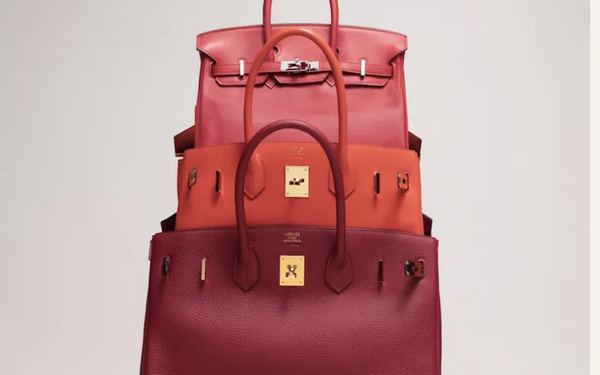Commentary
Is Hermes Birkin Up The Wrong Tree?
- by Barbara Lippert , Columnist, March 29, 2024

Financial gurus like Suze Orman say you shouldn’t buy a flashy new car because it loses at least 20% of its value the minute you drive it off the lot, right?
How about if we put you into a much superior financial vehicle -- something with clean lines, ample space, offering “rare heritage leather” and saddle-stitching?
I’m talking about a Birkin, the iconic leather satchel-ish handbag named after model Jane Birkin that elite French brand Hermès introduced to stores in 1984. Its back story goes that the CEO of Hermès sketched the design for Birkin in 1981 on a vomit bag, after he sat next to her on an airplane and saw all her belongings fall out of her handbag. (Which is interesting, since every large-sized Birkin I’ve spotted being schlepped around in the field is unlatched and hanging open to some degree).
advertisement
advertisement
The Birkin trend didn’t really take off until the hyper-acquisitive ‘90s. Victoria Beckham is rumored to own over 100 of them.
Back in the ‘90s on “Sex and the City,” the early influencer Samantha character tried to purchase one for $4,000. Now they go for anywhere from about $10,000 up to $250,000 and beyond, depending on size, color and texture.
Birkins seem to have become what the word “coveted” was invented for.
Lately, in fact, they’ve made news for being a better investment than gold bars.
“I know several instances where people have doubled their money based on buying it 10 years ago, and reselling it today in pristine condition,” James Firestein, an authenticator and founder of resale platform OpenLuxury, recently told Fortune magazine.
“The resale value of particularly the Birkin and Kelly [a sister handbag named after Grace] over the past 10 years has outpaced gold,” he said. Another reseller said that they also have outdone the S&P.
So how about we Madbloggers go in on a group venture?
Wait a minute. (Or hold your horses, which seems more on the nose, since the company was founded to craft leather harnesses for the horses of French aristocrats.)
Because just as with the famous brass clasp on the bag itself, there’s a catch.
Unless you have an established Hermes pedigree from having spent many tens of thousands of dollars on other items, like shoes, scarves, belts, blankets, etc, you’re dead meat walking. Even after having a relationship, you’d have to get on a wait list, and you won’t necessarily ever get offered the bag you signed up for. Walking into a Hermes shop and buying a Birkin is like trying to go to Mars.
Scarcity works, and the practice has actually been going on for ages. There’s even a famous story that circulated in New York City gossip circles more than 20 years ago about Jerry Seinfeld and his wife Jessica popping into a store with their toddler in a stroller, like regular humans.
Jessica asked a salesperson for a Birkin and was told that was “impossible,” since there’s a waiting list of more than a year. She slyly turned her eyes to her husband, and the clerk, now recognizing him, did a double take, and ran, red-faced, to get the manager. He came out and offered to usher Mrs. Seinfeld into a private room to look at the one bag that a customer hadn’t picked up.
Even back then, Hermes furiously denied the story, saying that Jessica Seinfeld had already been on a waitlist and was just coming in to pick up her bag.
Rich people problems; some prestigious watch, yatcht, art, and even car dealers use the same tactics.
Except now, two individual shoppers in northern California have filed a class-action lawsuit accusing Hermes of using “unfair business practices,” alleging that the French luxury brand violated federal and state antitrust laws by illegally "tying" the purchase of Birkin bags to the purchase of the luxury brand's other items.
And now that it's a highly public case, it could threaten other luxury fashion brands using similar tactics.
Hermes has already argued that each bag is handmade by one artisan who took five years to train and works on that one bag for about 40 hours (for real.) Plus, French law demands that that same artisan work under 35 hours a week. Those are indeed rich, almost comically French, problems.
Will the lawsuit change the system? I doubt it.
And I’ve already come to terms with the fact that should I ever get near a Birkin, the market would crater immediately.



